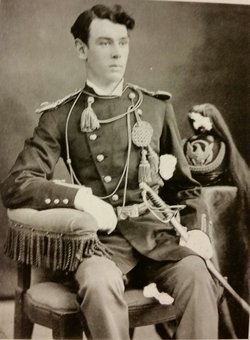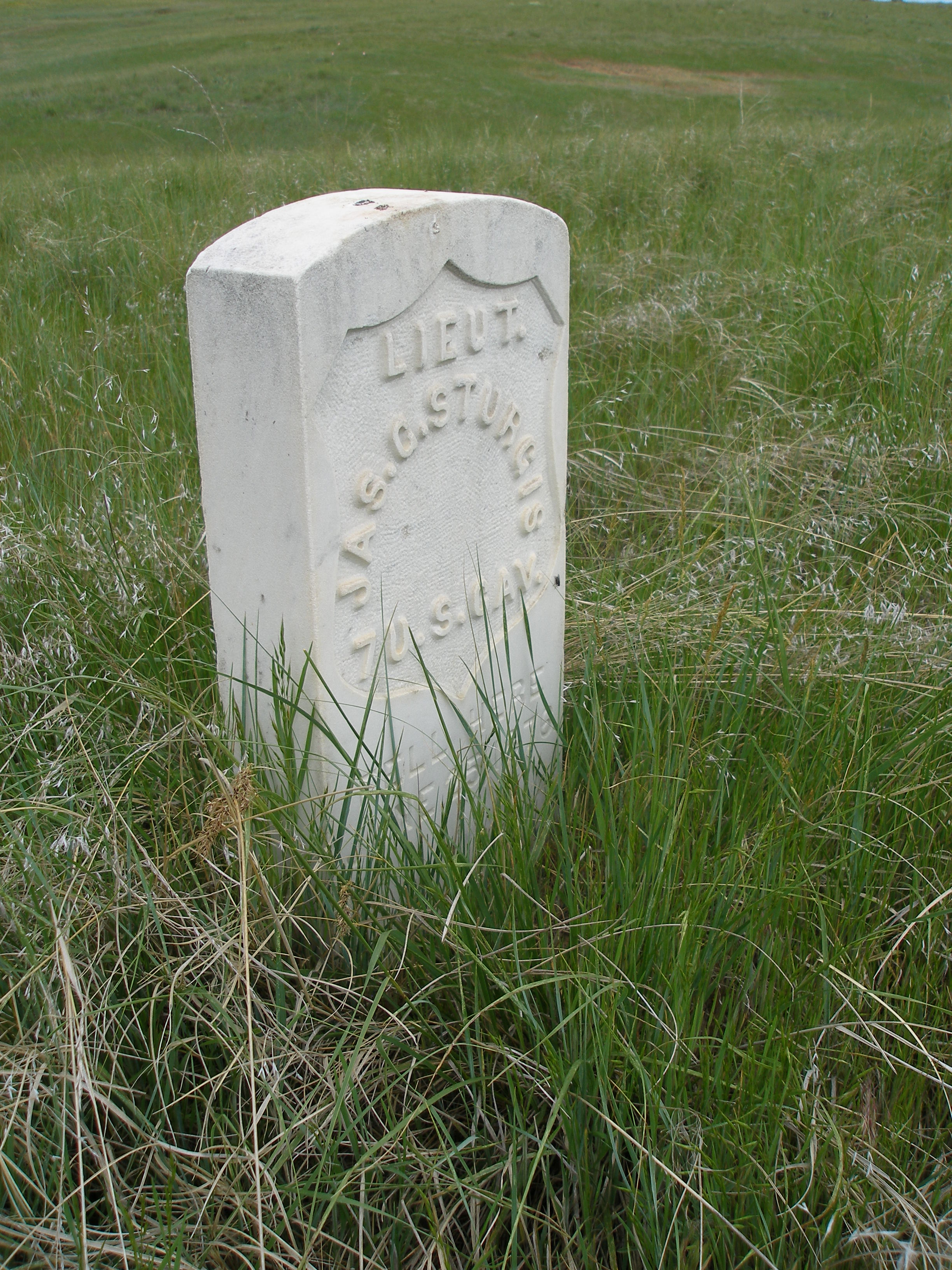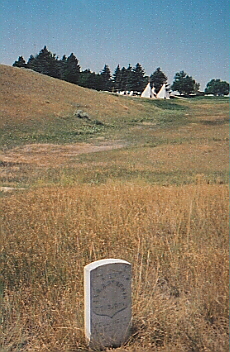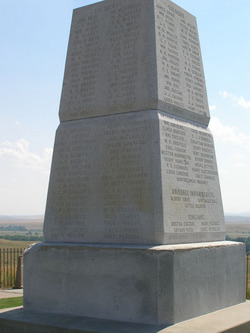The son of Colonel Samuel Davis Sturgis, Commander of the 7th US Cavalry (Colonel Sturgis was on recruiting duty at the time of the Battle of the Little Big Horn and did not rejoin his command until after the battle), and Jerusha Wilcox Sturgis, he entered the US Military Academy in 1871 by appointment at large. The 2578th Graduate, he ranked 29th of 43 graduates, in the class of 1875. Appointed 2nd Lt, 7th US Cavalry, on 16 June 1875. Arrived at his duty station of Fort Abraham Lincoln, Dakota Territory, on 29 Oct 1875. During the Sioux Campaign of 1876, he was with Company E, 7th Cavalry, and accompanied Custer's column. His body was never positively identified, as the bodies of the dead soldiers were mutilated by the Indians, and he is presumed buried with the enlisted soldiers in the mass grave at the Battle Monument on Last Stand Hill. In 1877, when the bodies of the enlisted soldiers were being reinterred into a mass grave on top of Last Stand Hill, his mother, Jerusha Wilcox Sturgis, insisted on seeing the spot where her son died, and the soldiers created a fake stone grave on the battlefield for her to look at. ∼Original Burial Site of US Army Officer killed at the Battle of the Little Big Horn. 2nd Lt Sturgis was the son of Col Samuel Davis Sturgis, Commanding Officer of the 7th U.S. Cavalry Regiment. Lt Sturgis graduated from West Point on June 16, 1875, and appointed a 2nd Lt in his father's regiment. After various administrative assignments, Sturgis reported for duty at Fort Lincoln, Dakota Territory in October of 1875. He was assigned to Company M at Fort Rice, Dakota Territory. Sturgis' duties at Fort Rice were listed as signal officer. He was the youngest officer in the regiment. And though he was the son of the commanding officer, fellow officers in the regiment described Sturgis as "unpretentious." At the Battle of the Little Bighorn, Lt Sturgis was with Company E, the Gray Horse Troop, and part of LTC George A Custer's Battalion. Sometime during the Battle of the Little Bighorn, Sturgis was killed. His remains were never identified. Soldiers searching the battlefield for the remains of Custer's command found Sturgis' underwear on the other side of the Little Big Horn River in an abandoned Lakota/Cheyenne village. It is believed that his unidentified remains were buried where they had been found on the battlefield. Based upon battlefield excavations and warrior accounts of the battle, it appears that Company E fought hard and conducted a disciplined rear guard action until they overwhelmed and wiped out near Last Stand Hill. His mother, Jerusha Sturgis, had become increasingly distraught over not knowing if her son had been properly interred. So in June of 1878, Mrs. Sturgis made the journey to the remote battlefield to visit her son's gravesite. To avoid inflicting any further unhappiness to her, and to provide some comfort to a grieving mother, soldiers from a nearby fort created a fictitious and well marked grave on the battlefield. Sometime after 1890 a marker with Sturgis' name was placed near Deep Ravine. The marker should only be considered as a memorial, and not where Sturgis had been found and buried. In 1881 all known battlefield burials were moved to a mass grave on Last Stand Hill. Col Sturgis never forgave LTC Custer for the death of his son. And he became one of Custer's most vocal critics on the battle.
The son of Colonel Samuel Davis Sturgis, Commander of the 7th US Cavalry (Colonel Sturgis was on recruiting duty at the time of the Battle of the Little Big Horn and did not rejoin his command until after the battle), and Jerusha Wilcox Sturgis, he entered the US Military Academy in 1871 by appointment at large. The 2578th Graduate, he ranked 29th of 43 graduates, in the class of 1875. Appointed 2nd Lt, 7th US Cavalry, on 16 June 1875. Arrived at his duty station of Fort Abraham Lincoln, Dakota Territory, on 29 Oct 1875. During the Sioux Campaign of 1876, he was with Company E, 7th Cavalry, and accompanied Custer's column. His body was never positively identified, as the bodies of the dead soldiers were mutilated by the Indians, and he is presumed buried with the enlisted soldiers in the mass grave at the Battle Monument on Last Stand Hill. In 1877, when the bodies of the enlisted soldiers were being reinterred into a mass grave on top of Last Stand Hill, his mother, Jerusha Wilcox Sturgis, insisted on seeing the spot where her son died, and the soldiers created a fake stone grave on the battlefield for her to look at. ∼Original Burial Site of US Army Officer killed at the Battle of the Little Big Horn. 2nd Lt Sturgis was the son of Col Samuel Davis Sturgis, Commanding Officer of the 7th U.S. Cavalry Regiment. Lt Sturgis graduated from West Point on June 16, 1875, and appointed a 2nd Lt in his father's regiment. After various administrative assignments, Sturgis reported for duty at Fort Lincoln, Dakota Territory in October of 1875. He was assigned to Company M at Fort Rice, Dakota Territory. Sturgis' duties at Fort Rice were listed as signal officer. He was the youngest officer in the regiment. And though he was the son of the commanding officer, fellow officers in the regiment described Sturgis as "unpretentious." At the Battle of the Little Bighorn, Lt Sturgis was with Company E, the Gray Horse Troop, and part of LTC George A Custer's Battalion. Sometime during the Battle of the Little Bighorn, Sturgis was killed. His remains were never identified. Soldiers searching the battlefield for the remains of Custer's command found Sturgis' underwear on the other side of the Little Big Horn River in an abandoned Lakota/Cheyenne village. It is believed that his unidentified remains were buried where they had been found on the battlefield. Based upon battlefield excavations and warrior accounts of the battle, it appears that Company E fought hard and conducted a disciplined rear guard action until they overwhelmed and wiped out near Last Stand Hill. His mother, Jerusha Sturgis, had become increasingly distraught over not knowing if her son had been properly interred. So in June of 1878, Mrs. Sturgis made the journey to the remote battlefield to visit her son's gravesite. To avoid inflicting any further unhappiness to her, and to provide some comfort to a grieving mother, soldiers from a nearby fort created a fictitious and well marked grave on the battlefield. Sometime after 1890 a marker with Sturgis' name was placed near Deep Ravine. The marker should only be considered as a memorial, and not where Sturgis had been found and buried. In 1881 all known battlefield burials were moved to a mass grave on Last Stand Hill. Col Sturgis never forgave LTC Custer for the death of his son. And he became one of Custer's most vocal critics on the battle.
Gravesite Details
Actual burial site is unknown. Marker placed on battle to comfort his mother.
Family Members
Advertisement
Explore more
Sponsored by Ancestry
Advertisement















